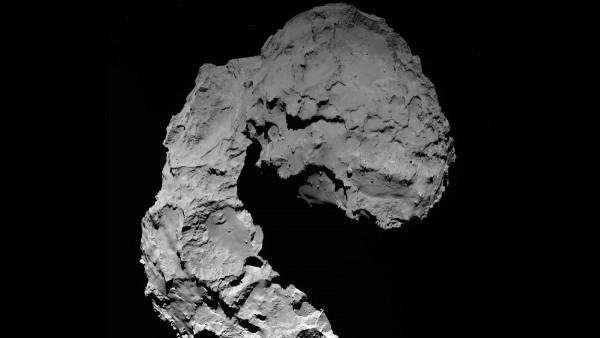By Ana Verayo, | September 30, 2016

This view shows Comet 67P/Churyumov-Gerasimenko as seen by the OSIRIS wide-angle camera on ESA's Rosetta spacecraft, when Rosetta was at an altitude of 14 miles (23 kilometers).
Comet chaser Rosetta spacecraft has plunged to its death on a comet.
The European Space Agency's history-making probe just crash landed on Comet 67P/Churyumov-Gerasimenko at 6:40 A.M. EDT, marking the end of its 12-year mission. A live broadcast of the probe's death plunge was streamed online on NASA TV.
Like Us on Facebook
However, confirmation of the probe's surface touchdown arrived later at 7:20 A.M. EDT as there is a 40-minute delay for signals to reach ground mission control. Rosetta and comet 67P are currently 447 million miles away from Earth, heading towards the outer orbit of Jupiter.
As the probe is zooming farther away from the sun, it will be hard to charge its solar panels for continued operations, which is the main reason why ESA mission control scientists and engineers decided to end this mission. The ESA announced that Rosetta experienced a slow and controlled impact on the comet's soft, dark pits.
Mission scientists say that Rosetta landed as gently as possible on the surface of comet 67P. However, since it is a spacecraft and it is not designed to land, it immediately lost contact at the moment of touch down.
The Rosetta mission was launched in March 2004 and is estimated to be worth US $1.46 billion. Rosetta arrived at comet 67P in August 2014. It is considered to be the first spacecraft to orbit a comet.
In November 2014, Rosetta deployed its lander known as Philae on the comet's surface. However, the lander suffered a bumpy landing, as it failed to anchor itself on the surface. Philae bounced twice and ended up under a dark shadow of a cliff that ultimately prevented it from charging its solar panels.
Philae managed to obtain precious data and imagery during its 60 hours of operations on the surface of the comet.
Mission scientists consider this a successful mission as both Rosetta and Philae revolutionized our understanding of comets. We now know that comets provided essential organic clues about how life began in the solar system, especially on Earth some 4.6 billion years ago.
Among Rosetta's crucial findings is the discovery of hard ice on the surface of the comet, radar mapping of the comet's entire surface, and the detection of amino acids on the comet.
-
Use of Coronavirus Pandemic Drones Raises Privacy Concerns: Drones Spread Fear, Local Officials Say

-
Coronavirus Hampers The Delivery Of Lockheed Martin F-35 Stealth Fighters For 2020

-
Instagram Speeds Up Plans to Add Account Memorialization Feature Due to COVID-19 Deaths

-
NASA: Perseverance Plans to Bring 'Mars Rock' to Earth in 2031

-
600 Dead And 3,000 In The Hospital as Iranians Believed Drinking High-Concentrations of Alcohol Can Cure The Coronavirus

-
600 Dead And 3,000 In The Hospital as Iranians Believed Drinking High-Concentrations of Alcohol Can Cure The Coronavirus

-
COVID-19: Doctors, Nurses Use Virtual Reality to Learn New Skills in Treating Coronavirus Patients







